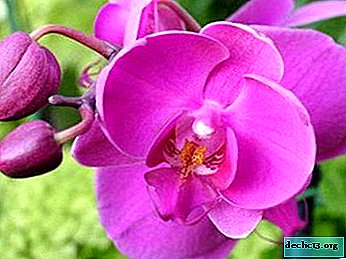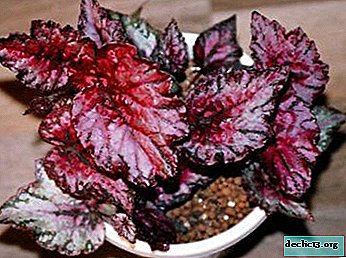Features of flowering orchids and rules of care during this period
 Orchid is a delicate and refined plant, flowering of which all flower growers are waiting. And this is not surprising, since at this time the flower looks simply incredible, and its pleasant aroma creates an atmosphere of harmony.
Orchid is a delicate and refined plant, flowering of which all flower growers are waiting. And this is not surprising, since at this time the flower looks simply incredible, and its pleasant aroma creates an atmosphere of harmony.
But there are a number of problems due to which flowering may be disturbed or even absent.
To prevent this, it is necessary to properly care for the plant and to know how to reanimate it.
Below will be described in detail the process of caring for the plant at home before, during and after flowering, as well as how to prolong the flowering period.
Process features
The following features are characteristic for flowering orchids:
- Flowering begins only after the orchids turn 2 years old;
- when transplanting a baby, the plant will have to wait until 6 air leaves are formed;
- for the orchid, calm and adaptation to one place remain important, so putting the pot out and changing its location is not worth it.
Conditions
In order for the tropical beauties to regularly please with colorful blooms and new buds, the following conditions must be observed:
- The formation of new peduncles is directly related to the state of the root system. Roots are active sites of photosynthesis, so they need to provide the necessary amount of light. Thus, the capacity of the orchid should be transparent.
- Home flowers need sunlight. With insufficient lighting, the flower will not grow. In summer, the lack of light is practically not noticeable, but in autumn and winter he needs to provide additional lighting.
- In order for the tropical beauty to please with new buds, it is necessary to observe the correct temperature regime. During the day, the temperature will be 20-24 degrees, at night - 15-18 degrees.
- Abundant and regular flowering is possible only with fertilizers containing potassium and phosphorus. But with a glut of nitrogen, only leaves will grow, flowering will stop.
- Watering should be moderate. An excess of moisture will adversely affect the ability of the orchid to frequently throw new peduncles.
Periods
In total, an orchid has 5 phases in its life cycle:
 Vegetation period. It begins with the formation of a new sprout. During this period, not only the leaves grow, but the root system is also actively developing.
Vegetation period. It begins with the formation of a new sprout. During this period, not only the leaves grow, but the root system is also actively developing.- Peace. At this time, the peduncle grows and new buds are laid.
- Flowering phase. This period of orchid life is the most intense. It requires more effort from the plant and takes a lot of energy.
- Rest period. It immediately follows flowering, not pronounced.
- Active vegetation. Under properly created conditions of maintenance and care, the flowering period ends.
How long does it last?
If the care of the plant is correct, then flowering will delight for several months. This happens 2-3 times a year. Flowering can occur in several stages: the previously blossomed inflorescences begin to wither, but at the same time the inflorescences that are formed later bloom.
You can find out how often an orchid blooms at home and how long this period can last here.
Is it possible to artificially stimulate?
To stimulate the flowering of orchids artificially, you can use the following recommendations:
- Use a stimulant for the growth and flowering of orchids. This product is sold in a flower shop. Spraying with such a drug is carried out in the morning during watering.
- You can fool the plant by arranging for it a mini-drought in a separate taken pot with phalaenopsis. This is a great way that works even under conditions of overfilling the flower with nitrogen compounds.
- Imitation of the "rainy season". You can cause a reaction in the orchid by performing daily watering with warm water, the temperature of which is 35 degrees. After 4 days, stop watering, and after 2 weeks, restore. After a 2-week tactic, you will have to return to the normal watering mode.
How does it bloom?
Flowering plants begins at the time of opening of the buds. They open smoothly and slowly. First, the side and upper petals, and only then the lip and the flower itself open. This process lasts about a day. After, within 2-3 days, you can observe a fully ripe orchid. The first to bloom buds, which are located closer to the end of the peduncle.
Photo
Below you will see the plant in bloom in the photo:





Home care before, during and after flowering
Nutrition and nutrition
Fertilizing is necessary, but just do it right. Before flowering, use nitrogen-rich formulations. But during and after flowering, the orchid needs potassium and phosphorus, as nitrogen will inhibit the development of buds. Potassium and phosphorus, in turn, stimulate the nucleation of buds and guarantee the appearance of healthy flowers.
Moisturizing
Indoor air must be humidified. There is no need to use special devices. All that is needed is a spray gun. They spray regularly the space near the orchid. You can also place containers with water near the flower.
Watering
As soon as the plant begins to bloom, it needs to change the watering regime. This process has certain features:
- Pour water directly into the roots of the flower. Watering should be done 2 times a week, but it should not be plentiful. It is necessary to monitor the state of the soil, which should not dry out, but also be waterlogged.
- During flowering, it is better to install the plant in a room with high humidity. This has a positive effect on his condition.
- After flowering, water the flower once a week, and from the moment of rest, it is enough to do this 1-2 times a month.
Transfer
The main reason for transplanting orchids is a small pot. We'll have to wait with this until flowering ends. Otherwise, it will adversely affect the condition of the flower.Proceed to transplant only after the flower has dropped its petals. The procedure is as follows:
- Carefully remove the plant from the pot without injuring the roots.
- Shake off the roots of the old earth, which is already thinned. Use scissors to remove rotten and weak roots.
- For transplanting, use a pot that is 1-2 sizes larger than the previous one.
- Lay the substrate on the bottom, place the orchid and add soil again. It should fill all the free space between the roots.
- Do not cover the top completely with soil. It is better that it is open and located below the side of the tank.
To minimize the consequences of the transplant, you will need to moisten the soil, and set the flower itself for a couple of days in a shaded place. This will allow him to rest.
How to crop?
This procedure is necessary after flowering, otherwise the branches will be small each time. In most cases, the peduncle should be cut a little higher than a well-developed bud, while leaving 5-6 mm above the bud. This will avoid draining. Use pruning shears to trim.
Read more about what care is needed for an orchid during its flowering and in other periods of life, read here, and from this article you will learn about the rules for caring for a flower after it has blossomed.
If not blooming
Causes
 There are the following reasons for the lack of flowering:
There are the following reasons for the lack of flowering:
- Non-compliance with dormant conditions, which involve a change in irrigation regimes and temperature.
- Incorrect temperature conditions. At elevated temperatures and non-observance of daily differences, the metabolic rate in the flower organism will decrease. As a result, the efficiency of photosynthesis decreases and the plant lacks energy. This results in stopping the bookmark of a new kidney.
- Wrong watering. The flowering period for orchids is a dry season. The flower is trying hard to protect itself from death.
- Improper feeding. It is not necessary to feed with a high concentration of nitrogen, because of this, the plant will increase its green mass, and flower stalks will be absent.
- To bookmark the peduncle, you need a sufficient amount of light. With its shortage, a flower supports life in the first place, of vital organs - leaves and roots.
What to do?
To solve the problem associated with the lack of flowering, it is first necessary to eliminate the cause. In addition, the following stimulation methods are used:
- Chemicals. The most popular is Epin. It is used for spraying. To carry out processing every day, preferably in the morning. Once a week, water the orchid with the addition of 3-5 drops of the drug. A positive effect on the plant is watering with a solution of succinic acid. It serves as a growth regulator and anti-stress drug. Dissolve 2 g of the drug in 1-2 l of water. Processing is carried out within 3 days.
- Temperature drop. To stimulate flowering, it is worthwhile to properly organize the temperature difference. To do this, you can make a flower at night on the balcony. The temperature at night should be 18 degrees. After that, rearrange the flower in a warm place. Such stress will lead to flowering.
Can this period be extended?
You can admire the beauty of orchids during flowering forever. To at least somehow extend this period, you can use the following recommendations:
- Do not rearrange the pot and try to touch it less.
- Do not overfeed the flower with fertilizers.
- Spray the tip of the peduncle.
Caring for an orchid during flowering is difficult. During this period, the plant requires increased attention, so you have to be patient. But such efforts will not be in vain, because during flowering the orchid looks incredibly beautiful and graceful, and this is the best reward for any grower.
Interesting video
Watch a video about orchid care during flowering:

 Vegetation period. It begins with the formation of a new sprout. During this period, not only the leaves grow, but the root system is also actively developing.
Vegetation period. It begins with the formation of a new sprout. During this period, not only the leaves grow, but the root system is also actively developing.















